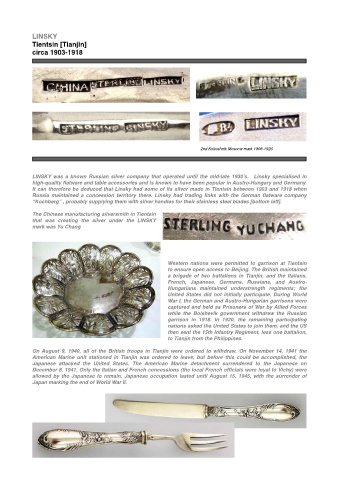Page 506 - Chinese SIlver By Adrien Von Ferscht
P. 506
LINSKY
Tientsin [Tianjin]
circa 1903-1918
2nd Kokoshnik Moscow mark 1908-1926
LINSKY was a known Russian silver company that operated until the mid-late 1930’s. Linsky specialised in
high-quality flatware and table accessories and is known to have been popular in Austro-Hungary and Germany.
It can therefore be deduced that Linsky had some of its silver made in Tientsin between 1903 and 1918 when
Russia maintained a concession territory there. Linsky had trading links with the German flatware company
“Kochberg” , probably supplying them with silver handles for their stainless steel blades [bottom left].
The Chinese manufacturing silversmith in Tientsin
that was creating the silver under the LINSKY
mark was Yu Chang
Western nations were permitted to garrison at Tientsin
to ensure open access to Beijing. The British maintained
a brigade of two battalions in Tianjin, and the Italians,
French, Japanese, Germans, Russians, and Austro-
Hungarians maintained understrength regiments; the
United States did not initially participate. During World
War I, the German and Austro-Hungarian garrisons were
captured and held as Prisoners of War by Allied Forces
while the Bolshevik government withdrew the Russian
garrison in 1918. In 1920, the remaining participating
nations asked the United States to join them, and the US
then sent the 15th Infantry Regiment, less one battalion,
to Tianjin from the Philippines.
On August 9, 1940, all of the British troops in Tianjin were ordered to withdraw. On November 14, 1941 the
American Marine unit stationed in Tianjin was ordered to leave, but before this could be accomplished, the
Japanese attacked the United States. The American Marine detachment surrendered to the Japanese on
December 8, 1941. Only the Italian and French concessions (the local French officials were loyal to Vichy) were
allowed by the Japanese to remain. Japanese occupation lasted until August 15, 1945, with the surrender of
Japan marking the end of World War II.

